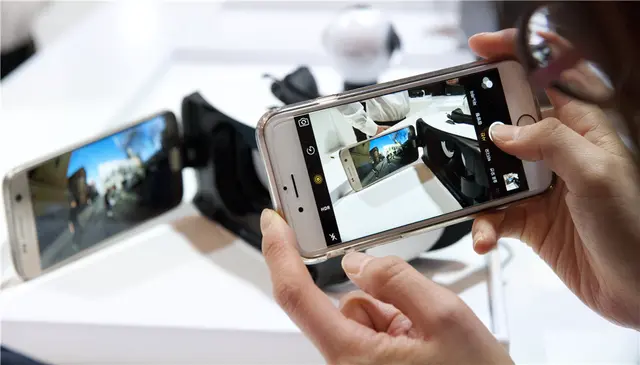(THE WALL STREET JOURNAL) Think of Samsung Electronics new flagship Galaxy S7 smartphone less as a groundbreaker—and more as a greatest hits album.
After shaking up its Galaxy smartphone design last year, Samsung is keeping much of that sleek glass and metal look for 2016. But for the reunion tour, the S7 brings back a number of gone-too-soon Galaxy S4 and S5 features that were actually useful, including expandable storage and waterproofing.
There’s nothing wrong with playing the hits. When I had the chance to spend a little time with the S7—which debuted on Sunday at Mobile World Congress and begins shipping March 11—I truly appreciated that it refines features that matter. There are fewer compromises than Samsung forced on us withlast year’s S6.
*The iPhone 6s (top) compared to the larger but almost-as-thin Galaxy S7.
Emily Prapuolenis / The Wall Street Journal
But I was also left wondering if that’s enough. What justifies Samsung’s premium at a time of growing competition from cheap but impressive Chinese rivals?
The Galaxy S7 comes in two flavors, neither of which has yet been assigned a price. A basic 5.1-inch-screen version feels slightly smaller in the hand than theS6, and is almost as slim asthe 4.7-inch iPhone 6s. And an S7 Edge model has curved glass sides on a larger 5.5-inch screen. It promises a full phablet experience that’s slimmer and lighter than a 5.5-inch iPhone 6s Plus.
As usual, Samsung is putting its own version of Android (6.0 Marshmallow) on this phone. Software is where Samsung often goes off the rails, but I liked some additions I saw such as a self-diagnostic tool and—on the Edge—a dedicated Tasks menu for one-touch access to apps, news or the selfie camera.
The camera bump on last year’s Galaxy S6 is almost gone on the Galaxy S7.
Emily Prapuolenis / The Wall Street Journal
Samsung boasts camera improvements on the S7. For starters, the unsightly bulge that marred past Galaxy phones has been slimmed to a hair. Inside, the camera now has a 12-megapixel sensor. Technically that’s lower resolution than the 16-megapixel S6, but Samsung says it has made each pixel larger to capture 95% more light, so it should perform much better in darker situations.
In a demo set up by Samsung, the S7 focused more rapidly in low light than an iPhone. I’ll be eager to put the new S7 camera through my own real-life review. (Incidentally, the camera’s native aspect ratio is no longer “widescreen” 16:9, but 3:2, like the iPhone.)
Now for those blasts from the past: Both phones have beautiful AMOLED screens that, amazingly, show you the time and other key info without firing up the whole screen. This low-energy perk echoes a nighttime clock feature first seen on 2014’s Note Edge.
Instead of adopting the USB Type-C port found on the newest laptops and some Android rivals, the S7 sticks with the Micro USB charging cables it’s used for years.
The Galaxy S7 brings back a MicroSD card slot, hidden in its SIM tray.
Geoffrey A. Fowler/The Wall Street Journal
Expandable storage, which departed too dearly before the S6, is also back. You can now stick a MicroSD card in the SIM card tray to expand on the 32GB of storage that comes standard.
And get ready to hit the pool because the S7 iswaterproof, just like the S5. In a brief test, I stuck it under a water fountain while it played an Adele video, and she kept on crooning. Even better, the S7’s waterproofing doesn’t require a water-tight plug on the USB charging port, like the S5 did.
The Galaxy S7 is waterproof, like the Galaxy S5 but not last year’s Galaxy S6.
Emily Prapuolenis / The Wall Street Journal
One Galaxy S5 feature that didn’t make it back is a removable battery. The S7’s battery is still sealed in—but it is 18% larger than last year’s. (The S7 Edge’s battery is even larger.) Actual battery life is dependent on many factors including software tweaks, so I’ll let you know the impact of the extra juice in my review.
Little of this pushes smartphone design forward. That’s especially evident when you compare Samsung to rivalLG ElectronicsInc.066570.SE+2.96%, which also debutedits new flagship G5 smartphoneon Sunday.
LG’s latest isn’t waterproof, but does have the new USB Type-C port and a modular design that lets you swap in and out bases that add special capabilities, such as extra battery life, camera controls and high-resolution audio. And the G5 has not one but two cameras on the back, so you can switch between wide-angle and typical medium shots.
Samsung’s sales pitch is that it’s got the whole package—a lineup of hardware and services that’s unique, useful and builds upon itself. Samsung phones do make it easy to pass photos and video over to recent-model Samsung TVs, the world’s top sellers. The Samsung Pay service lets your phone replace a credit card even at stores with old-fashioned swipe terminals.
Samsung’s Gear 360 can capture 360-degree photos and 4K video by stitching together images from two fisheye cameras.
Geoffrey A. Fowler / The Wall Street Journal
Samsung’s Gear VR headset and software offers a foray into virtual reality that’s tough to match in quality and price. And Samsung is building on its VR capabilities with a new spherical camera called the Gear 360 that connects to Samsung’s phones to capture, view and share 360-degree video and still images.
The key to all of these experiences? A Samsung phone. Both new Galaxy models do the best job yet of highlighting Samsung’s edge.
 简体中文
简体中文



